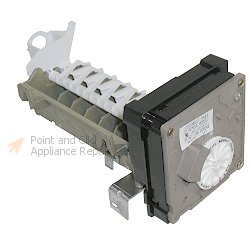
Monday, October 26, 2009
Tuesday, October 20, 2009
Frigidaire Refrigerator Model FRS6R3EW3 Control Panel




Importance of Refrigeration:
Refrigeration slows bacterial growth. Bacteria exist everywhere in nature, including
in the foods we eat. When bacteria have nutrients
(food), moisture, and favorable temperatures, they
grow rapidly, increasing in numbers to the point
where some types of bacteria can cause illness.
Bacteria grow most rapidly in the range of
temperatures between 41°F and 140 °F (the "Danger
Zone"), some doubling in number in as little as 20
minutes. A refrigerator set at 41°F or below will
protect most foods.
Pathogenic (disease causing) bacteria can grow
rapidly in the "Danger Zone," the temperature range
between 41°F and 140 °F, but they do not generally
affect the taste, smell, or appearance of a food. In
other words, one cannot tell that a pathogen is
present.
Safe Refrigerator Temperature:
For safety, it is important to verify the temperature of the
refrigerator. Refrigerators should be set to maintain a
temperature of 41°F or below. An appliance thermometer
should be kept in the refrigerator to monitor the
temperature. This can be critical in the event of a power
outage. When the power goes back on, if the refrigerator
is still 41°F, the food is safe. Foods held at temperatures
above 41°F for more than 4 hours should not be
consumed. Appliance thermometers are specifically
designed to provide accuracy at cold temperatures. Be
sure refrigerator/freezer doors are closed tightly at all
times. Don't open refrigerator/freezer doors more often
than necessary and close them as soon as possible.
Monitor the temperature:
A thermometer is important in monitoring the temperature in your refrigerator.
Refrigerator thermometers, which are relatively inexpensive, are designed
specifically to be accurate at cold temperatures. It is a good idea to place the
thermometer near the center of the refrigerator in a convenient and easy-to-read
location. Make a habit of checking the temperature regularly, preferably at least once
a day.
Sources:
Refrigeration and Food Safety, Food Safety and Inspection Service (FSIS), United States Department of Agriculture, January 1999.
